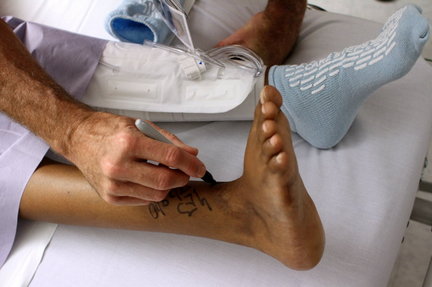 With the incredible amount of medical technology available in the United States it is hard to believe that doctors are performing procedures on the wrong patient or body part with regularity. Wrong site surgery is a very real problem in Georgia and the rest of the country. As a medical malpractice lawyer, I’ve discussed this problem with numerous doctors and they have all agreed that wrong site surgeries should never happen and are easy to avoid. Amazingly, according to a 2006 study looking at the frequency of surgical errors in the United States, the findings suggest that there could be as many as 2700 mistakes each year where a surgery is performed on the wrong body part or patient. This is about seven per day.
With the incredible amount of medical technology available in the United States it is hard to believe that doctors are performing procedures on the wrong patient or body part with regularity. Wrong site surgery is a very real problem in Georgia and the rest of the country. As a medical malpractice lawyer, I’ve discussed this problem with numerous doctors and they have all agreed that wrong site surgeries should never happen and are easy to avoid. Amazingly, according to a 2006 study looking at the frequency of surgical errors in the United States, the findings suggest that there could be as many as 2700 mistakes each year where a surgery is performed on the wrong body part or patient. This is about seven per day.
Recently Jesse Matlock, a 4-year-old Oregon boy was a victim of this sort of surgical error when he went in for a procedure to operate on a lazy right eye. Though the doctor performed several safety steps, including writing her initials above the boy’s right eye, and performing a final safety “time-out,” making sure that the correct patient is about to undergo the correct procedure, the doctor still managed to operate on the boy’s healthy right eye. In explaining her mistake the doctor said, “Frankly, I was at the head of him, and I lost my sense of direction and the mark got covered up. By the time I realized it was the left eye, it was all said and done.”
One question for anyone about to go into an operation is obviously what causes this type of error to occur? A 2010 study done for the Archives of Surgery found that among operations on the wrong part of the body, 85% were due to errors in judgment, with 72% of those doctors not performing a “time-out” as required by protocol. The study found the groups most frequently involved in operations on the wrong patient were doctors of internal medicine, who were responsible for 24% of these types of mistakes; orthopedic surgeons were responsible for 22.4%, general surgeons for 16.8%, and anesthesiologists for 12.1%.
Articles Posted in Medical Malpractice
Editorial on Georgia’s Medical Malpractice Tort Reform
With the Supreme Court of Georgia’s recent monumental decision on medical malpractice damages caps, the tort reform debate is back in the news. As a Marietta Medical Malpractice Lawyer, when I saw that Joe Kirby (Editor of the Editorial Page of the Marietta Daily Journal) had written an article on medical malpractice damages caps, I was curious to see what his take on the issue would be. The MDJ’s Editoral Page has a long standing reputation as a respected conservative voice for Metro Atlanta.
Mr. Kirby’s article on med mal tort reform is a refreshing look at the issue without a political bias. If you are interested in learning more about the practical effect of tort reform I recommend you read this MDJ article.
Georgia Medical Malpractice Damages Caps Ruled Unconstitutional by the Georgia Supreme Court (Nestlehutt Case)
 In 2005, under extreme pressure from the insurance industry, the Georgia Legislature passed sweeping tort reform measures (known as SB3) drastically changing Georgia law. At the heart of SB3 is OCGA § 51-13-1, which limits noneconomic damages in medical malpractice actions. Under this law no matter what value a jury places on a human life, the loss of a limb, the ability to see, or other catastrophic injury the award must be reduced to an arbitrary limit imposed by the Legislature. Today, the Supreme Court of Georgia in an unanimous 7-0 decision, Atlanta Oculoplastic Surgery, P.C. v. Nestlehutt et al., held noneconomic caps on damages unconstitutional.
In 2005, under extreme pressure from the insurance industry, the Georgia Legislature passed sweeping tort reform measures (known as SB3) drastically changing Georgia law. At the heart of SB3 is OCGA § 51-13-1, which limits noneconomic damages in medical malpractice actions. Under this law no matter what value a jury places on a human life, the loss of a limb, the ability to see, or other catastrophic injury the award must be reduced to an arbitrary limit imposed by the Legislature. Today, the Supreme Court of Georgia in an unanimous 7-0 decision, Atlanta Oculoplastic Surgery, P.C. v. Nestlehutt et al., held noneconomic caps on damages unconstitutional.
The Supreme Court ruled “OCGA § 51-13-1 clearly nullifies the jury’s finding of fact regarding damages and thereby undermines the jury’s basic function…Flat caps on noneconomic compensatory damages…violate this State’s constitutional guarantee that ‘the right to trial by jury shall remain inviolate.'”
As one who believes in protection of our sacred constitutional rights and also a strong believer in victims’ rights, I could not be more pleased with the Supreme Court’s decision. Today is a great day for Georgia and for Betty Nestlehutt. Click here to watch Betty Nestlehutt’s story.
ER Gross Negligence Statute Upheld by the Supreme Court of Georgia
 Since 1863, Georgia law has required that those practicing medicine for compensation must bring to the exercise of their profession a reasonable degree of care and skill, and Georgia law has provided that any injury resulting from a want of such care and skill shall be a tort for which recovery may be had. In 2005, all that changed, and ER physicians in our State were no longer required to practice with care and skill. This new law, codified at OCGA § 51-1-29.5 (c), was part of the tort reform package proposed by the insurance industry and passed by the Georgia Legislature in 2005. Those injured or killed by ER malpractice can no longer recover unless they can prove a much higher burden of gross negligence. This week in a 4-3 decision, Gliemmo et al. v. Cousineau et al., the Supreme Court of Georgia upheld the ER gross negligence statute as constitutional.
Since 1863, Georgia law has required that those practicing medicine for compensation must bring to the exercise of their profession a reasonable degree of care and skill, and Georgia law has provided that any injury resulting from a want of such care and skill shall be a tort for which recovery may be had. In 2005, all that changed, and ER physicians in our State were no longer required to practice with care and skill. This new law, codified at OCGA § 51-1-29.5 (c), was part of the tort reform package proposed by the insurance industry and passed by the Georgia Legislature in 2005. Those injured or killed by ER malpractice can no longer recover unless they can prove a much higher burden of gross negligence. This week in a 4-3 decision, Gliemmo et al. v. Cousineau et al., the Supreme Court of Georgia upheld the ER gross negligence statute as constitutional.
The case began in 2007, when Carol Gliemmo presented to St. Francis Hospital with serious pain behind her eyes, a sudden snapping in her head, and elevated blood pressure. Mark Cousineau, MD of Emergency Medical Specialists of Columbus, P.C. wrote her a prescription for Valium and sent her home. Two days later her primary care physician ordered a CT scan, which revealed a brain hemorrhage. As a result of the brain hemorrhage going untreated Carol Gliemmo was paralyzed.
So, even though expert physicians can agree that Dr. Cousineau breached the standard of care required of emergency physicians and caused this woman’s paralysis she cannot recover under Georgia law. It’s still difficult to believe this is the state of the law in Georgia. I’m certain Georgia medical malpractice lawyers will continue to fight for injured victims, but times are grim in Georgia. Of course Atticus Finch would say courage is knowing you’re licked before you begin but you begin anyway and you see it through no matter what. You rarely win, but sometimes you do.
The Supreme Court of Georgia Upholds the “Offer of Settlement” Statute, OCGA § 9-11-68
 In 2005, by the narrowest of margins, the Georgia Legislature passed sweeping changes to Georgia’s tort laws, known as SB3. Included in those changes was the new “Offer of Settlement” statute, codified at OCGA § 9-11-68. The Offer of Settlement statute has created a new mechanism for punishing a party to litigation with attorney’s fees. Georgia already has two statutes (OCGA §§ 9-15-14 and 13-6-11) that subject parties to statutory penalties, including attorney’s fees, for bringing frivolous suits or unreasonably litigating matters. The Offer of Settlement statute is different in it applies to all cases even meritorious suits that prevail at trial. This statute sets up situations where injured victims may win a jury verdict but end up with a net loss because the insurance companies’ attorney’s fees exceed the verdict. This week, the Supreme Court of Georgia in a 5-2 decision upheld the Offer of Settlement statute overruling the trial court’s finding that the statute violated the Georgia Consitution’s right to access the courts.
In 2005, by the narrowest of margins, the Georgia Legislature passed sweeping changes to Georgia’s tort laws, known as SB3. Included in those changes was the new “Offer of Settlement” statute, codified at OCGA § 9-11-68. The Offer of Settlement statute has created a new mechanism for punishing a party to litigation with attorney’s fees. Georgia already has two statutes (OCGA §§ 9-15-14 and 13-6-11) that subject parties to statutory penalties, including attorney’s fees, for bringing frivolous suits or unreasonably litigating matters. The Offer of Settlement statute is different in it applies to all cases even meritorious suits that prevail at trial. This statute sets up situations where injured victims may win a jury verdict but end up with a net loss because the insurance companies’ attorney’s fees exceed the verdict. This week, the Supreme Court of Georgia in a 5-2 decision upheld the Offer of Settlement statute overruling the trial court’s finding that the statute violated the Georgia Consitution’s right to access the courts.
In her dissent, the honorable Justice Hunstein artfully explained why this statute does in fact violate our constitutional access to the courts as follows: “OCGA § 9-11-68(b)(1) penalizes plaintiffs with meritorious causes of action for an impossiblity, namely, their failure to see into the future so as to calculate the precise amount a factfinder may award them for the damages they reasonably believed they sustained at the hands of the defendants…No party intending to file a cause of action in tort can foresee whether she will recover ‘enough’ money to avoid the effect of OCGA § 9-11-68(b)(1).”
The practical effect of this statute is that it will make it extremely difficult for middle class Georgia citizens to pursue meritorious cases. As discussed above, if an injured person fails to recover “enough” money from the jury, the insurance company can take a judgment against the injured person for the attorney’s fees they paid defending the case. Those without significant assets will not be deterred from pursing meritorious cases, because there is no way to collect a judgment against someone that has nothing (also known as “judgment proof”). The wealthy will still seek justice and their day in court knowing they can afford the unlikely result of a lower than expected jury verdict in their favor. The middle class injured victim is the only one truly stung by this new law. Many will still seek justice, but there are those that will forgo pursing recovery for their broken bones and medical expenses because the fear of having to pay for the insurance companies’ lawyer. This new law is just one of many challenges an experienced Georgia personal injury lawyer must negotiate in the mine field that is civil litigation.
Powerful Video; True Story of a Georgia Medical Malpractice Victim (The Nestlehutt Case)
The above video illustrates why we need government watchdogs, consumer advocates and Georgia trial lawyers fighting for the constitutional right to a jury trial. If you watch the video you will understand why the American System of Civil Justice should be protected from the insurance companies. We continue to pray for a favorable ruling from the Georgia Supreme Court to return Georgia to a place where judges and juries decide what is appropriate compensation for medical malpractice victims.
Illinois Supreme Court Holds Medical Malpractice Caps Unconsitutional
 Proponents of civil justice are celebrating and insurance companies are fuming in the wake of yesterday’s decision by the Illinois Supreme Court. Illinois’ highest court ruled capping damages for victims of medical malpractice violated the State Constitution’s separation of powers clause by imposing decisions reserved for judges and juries. That is a huge win for the citizens of Illinois.
Proponents of civil justice are celebrating and insurance companies are fuming in the wake of yesterday’s decision by the Illinois Supreme Court. Illinois’ highest court ruled capping damages for victims of medical malpractice violated the State Constitution’s separation of powers clause by imposing decisions reserved for judges and juries. That is a huge win for the citizens of Illinois.
I’ve defended a huge number of doctors and hospitals in medical malpractice lawsuits, I have doctors in my family, and I have a really high opinion of the medical profession. As a Georgia medical malpractice lawyer, I recognize healthcare is a problem in our country. However, caps on medical malpractice damages are not the answer. Unless the question is how do we further victimize those that have been catastrophically injured by medical negligence.
For those that don’t know, medical malpractice caps mean this: No matter what a doctor or hospital does to you. No matter how egregious the malpractice. No matter if the consequence is death, dismemberment, or disfigurement. You CANNOT recover what the judge and jury think your case is worth if it exceeds the arbitrary cap. In Georgia the cap is $350,000. If you are a housewife, retired, or unemployed and killed by a doctor’s negligence the judge and jury cannot decide what your life is worth, $350,000 is the max. If a checked-out doctor cuts a baby’s penis off during circumcision, refuses to acknowledge her mistake, and the baby is forced to live a life disfigured, the jury’s verdict will be reduced to the arbitrary cap. Caps on damages were created by insurance companies to erode the civil justice system of trial by jury. For all its flaws, the American system of justice is still the best system in the world.
Georgia Victims of Medical Malpractice May Lose Access to the Courts if the Insurance Companies Have Their Way
Insurance companies are waging war on the American Civil Justice System. They consider the Right to Trial by Jury and the Rule of Law unnecessary speed bumps reducing insurance company profits. Insurance companies began their organized attack on the constitutional right to a trial by jury since before this Georgia Injury Lawyer started practicing law, over ten years ago. In recent years, Insurance companies in Georgia have been specifically targeting victims of medical malpractice.
Luckily, many still believe the American Civil Justice System is still the best system in the world and have taken up the fight to defend the Right to Trial by Jury. Recently, a leading civil justice blog addressed the question how many hoops should medical malpractice victims have to jump through to obtain justice? It is an excellent read.
 Marietta Injury Lawyer Blog
Marietta Injury Lawyer Blog

